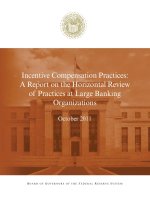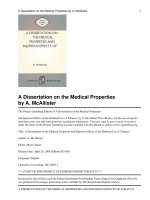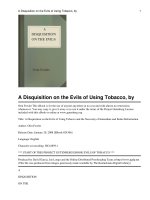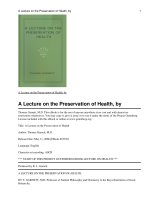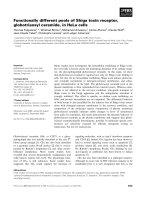A study on the incidence of shiga toxin producing Escherichia coli in dairy cattle and its environment
Bạn đang xem bản rút gọn của tài liệu. Xem và tải ngay bản đầy đủ của tài liệu tại đây (239.71 KB, 12 trang )
Int.J.Curr.Microbiol.App.Sci (2018) 7(11): 2461-2472
International Journal of Current Microbiology and Applied Sciences
ISSN: 2319-7706 Volume 7 Number 11 (2018)
Journal homepage:
Original Research Article
/>
A Study on the Incidence of Shiga Toxin Producing Escherichia coli in
Dairy Cattle and Its Environment
K. Venkateswara Rao1, A. Jagadeesh Babu2, T. Madhava Rao2,
Chinta Siva Swetha2*, P. Ramya4, Deepak3 and S. Somasekhar1
1
2
Department of Animal Husbandry, Andhra Pradesh, India
Department of Veterinary Public Health and Epidemiology, College of Veterinary Science,
Sri Venkateswara Veterinary University, Tirupati- 517502, India
3
Department of Animal Husbandry, Karnataka, India
*Corresponding author
ABSTRACT
Keywords
Escherichia coli,
Shiga toxin, PCR,
Faecal samples and
water samples
Article Info
Accepted:
18 October 2018
Available Online:
10 November 2018
The present study was designed to study the prevalence and characterization of shiga toxin
producing Escherichia coli from dairy animals, water samples in dairy farms and from
humans who were in close contact with animals. A total of 508 faecal samples from dairy
animals, 4 water samples from dairy farms and 28 Human faecal samples, who were in
close contact with animals were subjected to cultural and biochemical tests for
confirmation of E. coli. The molecular characterization of positive isolates with stx1, stx2,
eaeA and hlyA genes and multiplex PCR for confirmation. A total 522 samples were
positive for E. coli out of 540 (96.67%) samples by culture method, 319 (61.11%) positive
on blood agar plate assay and various biochemical characteristics were studied. Out of 522
positive E. coli, 56 (10.72%) are positive for STEC by PCR method. On multiplex PCR of
stx1, stx2, eaeA and hlyA genes 6 were positive 6 out of 56 (8.92%). The frequent isolation
of STEC strains from non human sources like animals, food and other products along with
the identification of multidrug resistance and virulence genes across the Indian
subcontinent poses a serious threat of the outbreaks in humans that can occur in the future.
Introduction
E. coli is an important member of the coliform
group. Based on the pathogenicity and
variation in biochemical characteristics, E.
coli has been classified into 6 categories, viz.
enterohaemorrhagic
E.
coli
(EHEC),
enterotoxigenic
E.
coli
(ETEC),
enteropathogenic
E.
coli
(EPEC),
enteroinvasive
E.
coli
(EIEC),
enteroaggregative E. coli (EaggEC) and
diffusely adherent E. coli (DEAC), of which
the EHEC is considered as most dangerous
group and also referred as shiga toxin
producing E. coli (STEC). STEC is an
important group of E. coli that can cause
severe diarrhoea and responsible for a number
of food borne outbreaks worldwide. The
STEC family is diverse and more than 200
serotypes of STEC have been identified so far
2461
Int.J.Curr.Microbiol.App.Sci (2018) 7(11): 2461-2472
and more than 160 of these have been
recovered from humans with haemorrhagic
colitis or haemolytic uremic syndrome (Abassi
K and Elahe T, 2015).
STEC strains produce cytotoxins known as
shiga toxins (stx) which have been classified
into two major classes they are shiga
toxin1(stx1) and shiga toxin2(stx2) and coded
by stx1 and stx2 genes respectively. In
addition to shiga toxins, most disease-causing
STEC strains produce a protein called intimin
that is encoded by the eae gene and is
involved in the enterocyte attaching and
effacing phenotype (Bakhshi et al., 2014).
Besides, a specific plasmid encoded
haemolysin called EHEC haemolysin, which
is encoded by ehxAgene, might contribute to
the virulence of STEC for humans (Bergy et
al., 1984).
Hence using run-off water from manure piles
contaminated with zoonotic STEC as a water
source for raising the fodder crops for animal
grazing, silage production for animal feed or
food crops for human consumption may result
in persistent animal infection and a great risk
of human exposure.
The first documentation of outbreak of STEC
was produced by an episode involving strain
O157:H7, in 1982 causing haemorrhagic
colitis (HC), since then the incidence of this
strain in the disease has increased annually
(Dastmalchi and Ayremlou, 2012). Further,
significant morbidity and mortality secondary
to infection be attributed to the development
of haemolytic uremic syndrome (Dhanashree
and Mallya, 2008) due to STEC because of its
association with several large outbreaks of
human illness with severe manifestations.
Contamination of feeds such as grain pellets,
soybean meal, silage grasses and grass hay
with STEC may occur due to contaminated
water used for cultivation of crops, spreading
of manure and slurry as fertilizers or via wild
birds or mammalian faeces (Brunen et al.,
2004).
Humans are infected with zoonotic STEC
mostly through the consumption of under
cooked hamburgers and ground beef products,
raw milk and milk products such as cheese,
curd, butter and ice creams. Person to person
transmission via the faeco-oral route has been
an important mode of transmission.
The ability of zoonotic STEC to survive and
persist in faeces, manure and soil in the
environment can be considered as a risk factor
for the infection of animals and humans. It has
been shown that STEC can survive for several
months in water or sediment from drinking
water troughs. STEC can also survive in soil
for long periods particularly in the presence of
manure, and during rain fall can be leached
out of the soil and travel below the top layers
of the soil for more than two months,
increasing the probability of contamination of
ground water which is recycled for crop
irrigation, vegetable cleaning or as drinking
water for animals and humans (Collins C and
Green AJ, 2010).
Water borne outbreaks of STEC associated
with recreational waters have been
increasingly reported since the early 1990’s.
Since, 1996 outbreaks of STEC, resulting
from a new mode of transmission have been
recognized i.e. direct contact between humans
and cows or calves at farms and fairs etc
(Duris et al., 2009).
Keeping in view of the public health
significance of STEC the present study was
designed to isolate and identify Escherichia
coli from farm water and faeces of dairy
animals and humans and molecular
characterization of the isolates to find out the
shiga toxin producing Escherichia coli by
using specific primers.
2462
Int.J.Curr.Microbiol.App.Sci (2018) 7(11): 2461-2472
Materials and Methods
Collection of samples
The faecal samples from cattle, water sources
of the concerned dairy farm and from the
persons who are working in the farms were
collected by using sterile cotton swabs for
cattle, sterilized glass bottles for water
samples and the persons were given sterilized
plastic containers to collect their faeces. A
total of 508rectal swabs from cattle, 4 water
samples and 28 human faecal samples were
collected aseptically in sterile normal saline
tubes. The collected specimens were
processed within 2 to 4 hours of collection.
The source and number of samples collected
in this study is given in Table 1.
Isolation and identification
Tryptic soy broth was used for enrichment of
inoculum. MacConkey agar and Eosine
Methylene Blue (EMB) agar were used for
isolation of Escherichia coli. Loop full of
inoculum from the normal saline tubes was
transferred to tryptic soy broth tubes and the
tubes were incubated at 370C for 24 hours.
After incubation a loop full of inoculum from
tryptic soy broth tubes was streaked over
MacConkey agar and Eosine Methylene Blue
agar plates and the plates were incubated at
370C for 24 hours. Identification of the isolate
was carried out by making a smear was from
the growth on MacConkey agar and Eosine
Methylene Blue agar plates and it was stained
with Grams method of staining. Gram
negative bacteria were identified up to genus
level as Escherichia based on morphology. All
the isolates were identified up to species level
based on biochemical tests (Fagan et al.,
1998). Test for haemolysis for the isolates of
Escherichia coli grown over night on Eosine
methylene blue agar plates were spot
inoculated on tryptose soya agar plates
containing 5% of disseminated sheep blood
cells. The plates were incubated at 37°C for 24
hours and appearance of haemolytic zone
around
the
colony
was
recorded.
Biochemically confirmed isolates were stored
in sterile Luria-Bertani glycerol broth vials
and mixed well in vortex mixer. The vials
were then labelled and stored for molecular
characterization of the isolates.
For confirmation of Shiga Toxin producing
Escherichia coli from the isolates Sorbitol
Mac Conkey agar part I and Part II were used
as a ready to use dehydrated media from M/s
Hi-Media Laboratories, Mumbai and prepared
as recommended by the manufacturer. All the
isolates were streaked on Sorbitol McConkey
agar plates and the plates were incubated at
37°C / 24 hours. After incubation the plates
were observed for pink colour colonies (Non
O157:H7) and colour less colonies (O157:H7).
Molecular characterization of isolates by
multiplex PCR
For the molecular characterization of the
isolates the reference strain for Shiga toxin
producing Escherichia coli MTCC 1699 was
obtained from Department of Veterinary
Public Health & Epidemiology, College of
Veterinary Science, Tirupati, Andhra Pradesh.
During the molecular characterization of the
isolates preparation of template DNA from
Escherichia coli strains was carried and
isolated. The primers used in the study were
custom synthesized by M/s Eurofins
Genomics, Banglore (India).The details of the
primers are given in Table.2.
A multiplex PCR assay was developed
through synthesis of specific primers targeting
stx1, stx2, eaeA and hlyA were used in our
study (10) with slight modifications. After
rapid DNA extraction, 5 µl of bacterial DNA
was added to a 25µl PCR mixture containing
50 mMKCl, 20mM Tris-HCl (pH 8.4), 2.5mM
2463
Int.J.Curr.Microbiol.App.Sci (2018) 7(11): 2461-2472
MgCl2, 0.2mM each deoxynucleoside
triphosphate (dATP, dUTP, dGTP, and dCTP)
(Thermo, USA), 2.0 µl of each primer, and 1.0
U of TaqDNA polymerase (Thermo, USA).
Amplification was performed by using a
Thermal cycler (Corbett Research, Germany).
Amplification was carried out at an initial
denaturation of 94°C for 3 min followed by a
cyclic denaturation at 94°C for 30 seconds,
55°C for 35 seconds and 72°C for 1 min for
35 cycles. Final extension step carried out at
72°C for 10 min. On completion of the
reaction, tubes with PCR products were held
at 4°C until further analysis/confirmation.
DNA amplified by PCR was subjected to
1.5% agarose gel electrophoresis (11). About
5 µl of each PCR product was mixed with 2 µl
of bromophenol blue (6X) loading dye and
loaded into each well. Electrophoresis was
performed at 5 v/cm and the motility was
monitored by the migration of the dye. After
sufficient migration, the gel was observed
under UV trans illumination using Alpha
innotech gel documentation system to
visualize the bands. The PCR product size was
determined by comparing with a standard low
molecular weight ladder marker.
Results and Discussion
The particulars of the samples which were
positive for Escherichia coli were given in
Table 3 and it’s characterization on cultural
characteristics on blood agar and MacConkey
and EMB agar.
The isolates were subjected to the biochemical
tests like IMViC tests, urease test and triple
sugar iron agar tests. For further confirmation
of Escherichia coli, all the isolates were
streaked on blood agar plates and incubated at
37°C/24 hours. The results revealed that 319
isolates produced β haemolysis on blood agar
plates.
For the phenotypic detection of shiga toxin
producing Escherichia coli, all
the
Escherichia coli isolates from different
sources were streaked on Sorbitol MacConkey
agar plates and the plates were incubated at
37°C / 24 hr. The results revealed that none of
the isolates have shown white colonies on
Sorbitol MacConkey agar plates but a total of
158 isolates have shown pink colonies.
In the present study an oligonucleotide primer
set was used which encodes the shiga toxins,
intimin and entero haemolysins produced by
the bacteria. Primers were selected on the
basis of published nucleotide sequence of the
180 bp for stx1, 255 bp for stx2, 384 bp for
eaeAand 534 bp for hlyA genes (Paton JC and
Paton AW, 1998). With the desired PCR
amplification of 180 bp for stx1, 255 bp for
stx2, 384 bp for eaeAand 534 bp for hly Agene
of shiga toxin producing Escherichia coli
(Figure 1).
In the present investigation, E.coli isolated
from the faecal samples of cattle from the
dairy farm of College of Veterinary Science,
Tirupati exhibited stx1 (4.34%), stx2 (2.89%)
and hlyA(1.44%) genes, E.coli isolates from
private dairy farm 1 revealed stx1 (8.00%),
stx2 (4.00%) and hlyA (12.00%) genes,
whereas the E.coli isolates from private dairy
farm 2 exhibited all the four genes in various
combinations viz., stx1 (1.34%), stx2
(1.00%),, eaeA (1.34%), hlyA (1.00%),
individually and a combination of stx1 + stx2
+ eaeA (1.34%), and stx1 + stx2 + eaeA +
hlyA (1.34%), In the private dairy farm 3 the
E.coli isolates from the faecal samples of
cattle revealed stx1 (3.70%), stx2 (2.77%),
eaeA (0.92%) and hlyA (3.70%) genes
individually and also a combination of stx1 +
stx2 + eaeA + hlyA (1.85%) genes (Fig. 1).
The percentage of toxigenic genes of the
isolates of Shiga Toxin producing Escherichia
coli of different sources was represented in
Table 4.
2464
Int.J.Curr.Microbiol.App.Sci (2018) 7(11): 2461-2472
From this study it is clear that pathogenesis of
STEC is multifactorial and involves several
virulence attributes of the organism. Rapid
and sensitive methods for detection of STEC
are now in force; especially there has been
advance in PCR technology, which has
increased the speed and has made it possible
to quantitate the number of STEC organisms
present in a suspected sample. These results
substantiate those obtained by other
methodological approaches followed by Fagan
et al., 1998, who detected the shiga toxin gens
(stx1 and stx2), intimin (eaeA) gene and
haemolysin (hlyA) genes in animal faeces by
multiplex PCR assay and reported that 19.45%
samples positive for stx1 and 6.7% samples
carried stx2, 35.9% samples positive for hlyA
gene and 6.7% samples positive for the eaeA
genes, Jamhidi et al., (2015) observed the
prevalence of shiga toxin producing E. coli in
healthy cattle and reported that 15% isolates
carried stx1, 19% possess stx2 alone and 8%
were positive for both stx1 and stx2 only,
Hallwell et al., (2016) detected shiga toxin
genes in cattle faecal samples and reported
that 85.8% positive for stx1, 60.0% carried
stx2 and 52.5% were posess eaeA genes,
Mahanti et al., (2013) analyzed the presence
of shiga toxins by multiplex PCR and reported
that 13.3% isolates carried stx1 gene and
12.12% isolates positive for stx2. Sridhar et
al., (2017) reported the prevalence of shiga
toxins in E.coli isolates from the cattle and
reported that 48.4% isolates carried stx1 gene,
22.4% possess stx2 gene, and 29.2% samples
positive for the both stx1 and stx2, Paula and
Marin (2008) observed the occurrence of nonO157 STEC in dogs with diarrhoea and they
reported that 7.6% isolates positive for stx1,
5.4% for stx2, 9.8% possess eaeA
genesand62% isolates carried stx1, stx2, hlyA
and eaeA genes, Islam et al., (2008) analyzed
the prevalence and genetic characterization of
STEC in slaughtered animals faecal samples
of cattle, buffalos and goats and reported that
buffalo and cattle faecal samples showed more
prevalence for both stx1 and stx2 genes than
stx1 or stx2 alone, Parul et al., (2016)analyzed
the STEC in cattle calves faeces samples and
reported that 37.5% samples were positive for
stx1,43.75% carried stx2 and 18.75% possess
both stx1 and stx2, 18.75% and 34.37%
isolates positive for eaeA and hlyA genes.
Dastmalchi and Ayremlou (2012) observed
the prevalence and characterization of STEC
in faeces of health and diarrhoeic calves, and
reported that, 23.1% of the isolates were
positive for only stx1, 26.92% isolates carried
stx2 alone, 26.92% samples were positive for
eaeA gene and 57.69% isolates were positive
for hlyA gene. Bakshi et al., (2014) observed
the presence of shiga toxin genes (stx1 and
stx2) and intimin (eaeA) genes in the faecal
samples of calves with diarrhoea, and reported
that 21 isolates were positive for the stx1, stx2
and eaeA genes, Kumar et al., (2014) reported
that among the 600 E.coli isolates, the
stx1(117) gene was significantly more
prevalent than stx2(53) and his study further
revealed that the eaeA and the hlyA gene were
significantly more prevalent in animal faecal
isolates. In this study, an attempt was made to
identify, isolate and characterize STEC from
animals with the help of available modern
method i.e. PCR. The samples were collected
from different sources like organized dairy
farms and local dairy units. This study showed
PCR to be more sensitive to characterize
STEC. The isolation of STEC was more in
diarrhoeic cattle in the present study which
correlated with the study of Brunen’s et al.,
(2004) as rearing of cattle is a very common
practice in Andhra Pradesh particularly in the
rural areas. Again, proper hygienic practices
and sanitary measures are lacking while
handling of the cattle in these areas. Thus, it
may be presumed that the diarrhoeic cattle’s
particularly can be an important source of
STEC causing human enteritis. Therefore,
emphasis should be given to screen the people
suffering from diarrhoea for presence of STEC
as a part of surveillance system. This will
2465
Int.J.Curr.Microbiol.App.Sci (2018) 7(11): 2461-2472
enable to reveal the actual magnitude of the
problem caused by STEC and also give early
warning regarding any outbreaks in future.
Four water samples from four different dairy
farms were screened for E.coli in the present
investigation and the results revealed that all
the four samples were positive for E.coli and
among them the isolates from the water source
of private dairy farm 2 exhibited stx1 and stx2
genes. Shojaei M (2017) studied about the
virulence factors of STEC in drinking water
and reported that out of 200 water samples 10
were positive for STEC among these one
isolate was positive for stx1, eaeA and ehlyA
genes and 4 isolates were positive for stx1 and
one for stx2. Lascowki et al., (2013) reported
through their investigations that Stx has been
implicated as a possible pathogenic agent in
drinking water responsible for gastrointestinal
illness outbreaks and further in all of these
cases, the presence of either stx1 and /or stx2
genes were confirmed, but the actual amount
of bacterial isolates that contained these genes
in the water source was not identified. They
examined 1850 water samples among these
300 were positive for E. coli in these 300 also
only 12 isolates were positive for STEC i.e.
two positive for stx1, 5 positive for stx2 and 5
positive for both stx1 and stx2 at the same
time no isolate was possess eaeA gene but all
12 were positive for ehxA gene. Ram et al.,
(2007) studied about the Prevalence of multiantimicrobial-agent resistant, Shiga toxin and
enterotoxin producing Escherichia coli in
surface waters of river Ganga and reported
that 30% of the 60 screened E. coli isolates
from these water sources contained either stx1
or stx2, Halabi et al., (2008) studied about the
prevalence of Shiga toxin-, intimin- and
haemolysin genes in Escherichia coli isolates
from drinking water supplies in a rural area of
Austria and 200 E. coli isolates were obtained
from various drinking water sources and
reported that only one was found to contain
stx2, Ram et al., (2007) have analyzed stx
gene presence in bacterial isolates obtained
from water samples indicate an even higher
percentage of stx gene presence in recreational
waters and their results revealed that, stx genes
were present in 22.7% of E. coli isolates
obtained from the river Ganga. Duris et al.,
(28) have analysed stx gene presence in
bacterial isolates obtained from water samples
and revealed that greater than 50% of faecal
coliform isolates tested positive for stx2 DNA
in river water in Maryland and river water
samples obtained in Michigan and Indiana.
Waste water has been attributed to pollution of
recreation and drinking water in specific cases
(Lienemann et al., 2011) the general efflux of
these to a water supply remains unknown,
especially in cases where water treatment
facilities are in effect. However, Walters et al.,
(2011) stated that attempts to relate stx gene or
stx-producing organism presence to indicators
of wastewater or faecal pollution have failed
to show a correlation in many cases. This
suggests that other factors besides general
wastewater efflux explain the presence of
microbes harbouring or expressing stx in
aquatic environments. These limited studies
set a wide range for which to compare stx
distribution and abundance in other drinking
water systems, will give information which is
important to know the prevalence of stxdependent illness arising from drinking water
both in animals and human beings.
In the present investigation 28 human faecal
samples were screened for E.coli and 18
isolated could be identified as E.coli. Among
these 18 isolates stx1, eaeA and hlyA genes
were carried by one isolate, 1 isolate carried
only hlyA gene and another isolate carried stx2
and hlyA genes. The findings of this study are
in association with Kumar et al., (2014)
isolated 11 STEC from 600 human faecal
samples with bloody and mucus diarrhoea and
reported that the stx1 gene was the most
common virulence gene, present in 11 (100%)
isolates followed by stx2 in six (54.5%)
2466
Int.J.Curr.Microbiol.App.Sci (2018) 7(11): 2461-2472
isolates and further they reported that the eaeA
gene was present in isolate from HUS patients
only, Kumar et. al.(2014) reported that among
the 600 E.coli isolates, the stx2 gene was
significantly more prevalent in animal faecal
samples than in human stool isolates, and his
study further revealed that the eaeA gene was
present in 4 human stool isolates and the hlyA
gene was significantly more prevalent in
animal faecal isolates than in human stool
isolates. Abassi and Elahe (2015) observed the
prevalence of STEC in urine samples of
patients suspected with UTI, by using
multiplex PCR assay by targeting stx1 and
stx2 genes and reported that 76 samples were
positive for E. coli and 5 STEC strains were
isolated by multiplex PCR and further
reported that 5 isolates positive for stx1, 2
carried eaeA and no isolate was positive for
stx2. Haugum et al., (2014) screened 12,651
stool samples of patients for a 5 years period
among these 138 patient were infected with
STEC in 138 positive STEC 108 isolates
positive for eaeA gene, 57 isolates carried
stx1, 50 possess stx2 and 21 were positive for
both stx1 and stx2. Virpari et al., (2013)
reported that 59 E. coli isolates that were
obtained from 100 faecal samples, of which
10.16% were positive for stx1, 15.25%
possess stx2 and 5.08% were positive for eaeA
gene. Sehgal et al., (2008) conducted 10 years
epidemiological survey of E. coli O157 across
India in humans and among 5678 human
samples, the survey results showed that only
30 (0.5%) samples were positive for E. coli
O157.
Table.1 Source and number of samples collected
S.No
1.
2.
3.
4.
5.
6.
Source of the sample
Number collected
Dairy farm, College of Veterinary Science, Tirupati
73
Private dairy farm 1
25
Private dairy farm 2
302
Private dairy farm 3
108
Water samples from the dairy farms
04
Human faecal samples
28
TOTAL
540
Table.2 Details of oligonucleotide primers used in this study
Primer
stx 1: F
stx 1: R
stx 2: F
stx 2: R
eaeA: F
eaeA: R
hlyA: F
hlyA: R
Target
gene
stx1
stx2
eaeA
hlyA
Primer sequence
(51 -31)
ATAAATCGCCATTCGTTGACTAC
AGAACGCCCACTGAGATCATC
GGCACTGTCTGAAACTGCTCC
TCGCCAGTTATCTTGACATTCTG
GACCCGGCACAAGCATAAGC
CCACCTGCAGCAACAAGAGG
GCATCATCAAGCGTACGTTCC
Expected amplicon
size(bp)
23
21
21
22
20
20
21
AATGAGCCAAGCTTGTTAAGCT 22
2467
Reference
Paton
and
paton
(1998)
Int.J.Curr.Microbiol.App.Sci (2018) 7(11): 2461-2472
Table.3 Prevalence of Escherichia coli from various sources
S.No
Source
1
Dairy farm
College
of
Veterinary Science,
Tirupati
Private dairy farm 1
Private dairy farm 2
Private dairy farm 3
Water samples
Human
faecal
samples
TOTAL
2
3
4
5
6.
No.
of No. of samples No.
of
samples
samples
positive for E.coli
positive for blood agar
screened
plate test
73
69 (94.52%)
44 (63.76%)
25
302
108
04
28
25 (100.00%)
298 (98.67%)
108 (100.00%)
04 (100.00%)
18 (64.28%)
12 (48.00%)
173 (58.04%)
86 (79.62%)
00 (00.00%)
04(22.22%)
540
522 (96.66%)
319 (61.11%)
Table.4 Screening and comparison of culture method for detection of Escherichia coli and
multiplex PCR for detection of Shiga toxin producing E.coli
S.
No
1
2
3
4
5
Source
Dairy farm
C.V.Sc.,
Tirupati
Private dairy
farm 1
Private dairy
farm 2
Private dairy
farm 3
Water samples
6 Human faecal
samples
Grand total
stx1
stx2
eaeA
hlyA
stx1, stx2,
eaeA
73
No. of
E. coli
by
culture
method
69
3 (4.34%)
2 (2.89%)
---
1 (1.44%)
---
stx1, stx2,
eaeA and
hlyA
---
25
25
2 (8.00%)
1 (4.00%)
---
3 (12.00%)
---
---
302
298
4 (1.34%)
3 (1.00%)
4 (1.34%)
3 (1.00%)
4 (1.34%)
4 (1.34%)
108
108
4 (3.70%)
3 (2.77%)
1 (0.92%)
4 (3.70%)
---
2 (1.85%)
04
04
---
---
---
18
1
(25.00%)
1 (5.55%)
---
28
1
(25.00%)
1 (5.55%)
1 (5.55%)
---
---
540
522
15
11
6
3
(16.66%)
14
4
6
No. of
samples
screened
Multiplex PCR for stx1, stx2, eaeA and hlyA genes
2468
Int.J.Curr.Microbiol.App.Sci (2018) 7(11): 2461-2472
Figure.1 Detection of Stx1, Stx2, eae and hlyA genes in samples collected from cattle in different
private farms
Dhanashree and Mallya (2008) screened the
diarrhoeagenic stool samples for STEC by
culture methods and PCR and reported that 2
were positive for hlyA and belonging to
serogroup O8 and also 110 eaeA positive E.
coli isolated recovered from stool samples.
identification of multidrug resistance and
virulence
genes
across
the
Indian
subcontinent poses a serious threat of the
outbreaks that can occur in the future.
In India various studies conducted have found
either no or rare occurrence of STEC in
humans in India. Except for diarrhoeal
outbreaks (Kang, 2001), STEC does not pose
a major threat to human health in India. It is
not clear that why the incidence of STEC is
low in India and other developing countries,
despite having all the reservoirs and STEC in
the food chain. Some researchers have argued
that under reporting of the incidence is the
cause, where as other showed that due to the
presence of pre-existing stx1, IgG antibodies
in asymptomatic cases offers positive
protection against STEC infection (Karmali,
1989). But the frequent isolation of STEC
strains from non human sources like animals,
food and other products along with the
The authors are thankful to the Sri
Venkateswara Veterinary University for
providing necessary fund and facilities to do
research in the Department of Veterinary
Public Health and Epidemiology, College of
Veterinary Science, Tirupati.
Acknowledgement
References
Abassi, K. and Elahe, T. 2015. Prevalence of
Shiga toxin genes and Intimin gene in
uropathogenic Escherichia coli. Journal
of Coastal Life Medicine Vol. 3(10).
791-796.
Bakhshi, B., Najibi, S. and Saeed SepehriSeresht. 2014. Molecular
2469
Int.J.Curr.Microbiol.App.Sci (2018) 7(11): 2461-2472
Characterization
of
Enterohemorrhagic
Escherichia coli isolates from Cattle. J
Vet Med Sci76(9): 1195–1199.
Bergy, DH., Hendricks, D., Holt, SG. and
Sneath, P.H. 1984. B.M. Systematic
bacteriology Vol.2 Williams and
Wilkins.
Brunen, SN. Carle, I. and Grimont, F. 2004.
Comparison of 14 PCR systems for the
detection and subtyping of stx genes in
Shiga-toxin-producing Escherichia coli.
Res Microbiol149:457–472.
Collins, C. and Green, AJ. 2010. Review of
the pathophysiology and treatment of
shiga toxin producing E. coli infection.
Practical Gastroenterology.
Dastmalchi, S. and Ayremlou. 2012.
Characterization of Shiga toxinproducing Escherichia coli (STEC) in
feces of healthy and diarrheic calves in
Urmia region, Iran. Iran. J. Microbol.
Vol.4. 63-69.
Dhanashree, B. and Mallya, PS. 2008.
Detection
of
shiga-toxigenic
Escherichia
coli
(STEC)
in
diarrhoeagenic stool & meat samples in
Mangalore, India. Ind J Med Res 128:
271-277.
Duris, JW., Haack, SK. and Fogarty, LR.
2009. Gene and antigen markers of
Shiga-toxin Producing E. coli from
Michigan and Indiana river water:
Occurrence and relation to recreational
water quality criteria. J Environ Qual
38:1878–1886.
Fagan, KP., Michael, A., Hornitzky, Karl, A.,
Bettelheim and Steven P. Djordjevic.
1998. Detection of Shiga-Like Toxin
(stx1 and stx2), Intimin (eaeA), and
Enterohemorrhagic Escherichia coli
(EHEC) Hemolysin (EHEC hlyA)
Genes in Animal Faeces by Multiplex
PCR. Appl Environ Microbiol 65(2):
868–872.
Fenlon, D.R. and Wilson, J. 2000. Growth of
Escherichia coli O157 in poorly
Fermented laboratory silage: a possible
environmental dimension in the
epidemiology of E. coli O157. Lett.
Appl. Microbiol 30 (2): 118-121.
Halabi, M., Orth, D., Grif, K., WiesholzerPittl, M., Kainz, M., Schoberl, J.,
Dierich, M.P., Allerberger, F. and
Wurzner, R. 2008. Prevalence of Shiga
toxin-, intimin- and Haemolysin genes
in Escherichia coli isolates from
drinking water supplies in a rural area of
Austria. Int J Hyg Environ Health 211:
454–457.
Hallwell, J., Tim, R., Stanford, K., Topp, Ed.
and Alexander, W. 2016. Monitoring
Seven
Potentially
Pathogenic
Escherchia coli Serogroups in a Cloed
Herd of Beef Cattle from Weaning to
Finishing Phases. Foodborne Pathogens
and Disease Vol.13(12) 661-667.
Hassan, M., FarhadSDi, Ebrahim, R.,
Hossein, E., and Reza, A. 2013.
Incidence of Shiga toxin-producing
Escherichia
coli
serogroups
in
ruminant's meat. Meat Science 95 381–
388.
Haugum, K., Brandal, L.T., Lindstedt, B.A.,
Wester, A.L., Bergh, K. and Afset, J.E.
2014. PCR-Based Detection and
Molecular Characterization of Shiga
Toxin- Producing Escherichia coli
Strains in a Routine Microbiology
Laboratory over 16 years. Journal of
Clinical Microbiology Vol. (52). 3156–
3163.
Islam, M.A., Abdus Mondol, Enne de Boer,
Rijkelt R, Beumer, Zwietering MH,
Kaisar A and Heuvelink AE.2008.
Prevalence
and
Genetic
Characterization of Shiga ToxinProducing Escherichia coli Isolates
from
Slaughtered
Animals
in
Bangladesh. Appl Environ Microbiol
74(17): 5414–5421.
Jamhidi A, Rad M and Zeinali T. 2015.
Detetion of Shiga toxin-producing
2470
Int.J.Curr.Microbiol.App.Sci (2018) 7(11): 2461-2472
Escherchia coli (STEC) in faece of
healthy calves in Mashhad, Iran.
Archive odRazi Institute, Vol. 0, No. 3
19-185.
Kang H. 2001. Sorbitol fermenting Shiga
toxin producing Escherichia coli
O157:H
strains:
epidemiology,
phenotypic
and
molecular
characteristics and microbiological
diagnosis. J ClinMicrobiol39: 2043–
2049.
Karmali
M.A.
1989.
Infection
by
verocytotoxin-producing
Escherichia
coli. Clinical Microbiological Reviews
15–38.
Kumar A, Neelam T and Meera S. 2014 An
Epidemiological and Environmental
Study of Shiga Toxin–Producing
Escherichia coli in India. Foodborne
Pathogens and Disease 11(6).
Lascowski KM, Guth BE, Martins FH, Rocha
SP, Irino K and Pelayo JS. 2013. Shiga
toxin-producing Escherichia coli in
drinking water supplies of northparana
state
Brazil.JApplMirobol.
Vol.
114(4).1230-1239.
Laura E, Silvana F, Alessia Z, Guerriero M,
Giuliana B, Gianluca S and Stefania S.
2016. Prevalence and characteristics of
verotoxigenic Escherichia coli strains
isolated from pigs and pork products in
Umbria and Marche regions of Italy.
International
Journal
of
Food
Microbiology 232 (2016) 7–14.
Lawan MK, Mohammed B, Junaid K, Laura
G, and Stefano M. 2015. Detection of
Pathogenic Escherichia coli in Samples
Collected at an Abattoir in Zaria,
Nigeria and at Different Points in the
Surrounding Environment. Int. J.
Environ. Res. Public Health, Vol.12,
679-691.
Lienemann, T, Pitkanen T, Antikainen J,
Molsa E, Miettinen I, HaukkaK,Vaara
M and Siitonen A. 2011. Shiga toxinproducing Escherichia coli O100:H: stx
(2e) in drinking water contaminated by
waste water in Finland. Curr. Microbiol.
62: 1239–1244.
Mahanti A, Samanta I, Bandopaddhay S,
Joardar SN, Dutta TK, Batabyal S, Sar
TK and Isore DP. 2013. Isolation,
molecular
characterization
and
antibiotic resistane of Shiga Toxin
producing Escherchia coli from buffalo
in India. Applied Microbiology Vol.56,
291-298.
Matussek A, Ing-Marie E, Jogenfor A,
Lofdahl S and Lofgren, S. 2016. Shiga
toxin-producing Escherichia coli in
Diarrhoeal stool of Swedish Children:
Evaluation of Polymerase Chain
Reaction Screening and Duration of
Shiga toxin shedding. J Paediatric Infect
Dis So Vol.5(2).147-151.
Nora L.P. and Analia I.E. 2014. Shiga toxin producing
Escherichia
coli
in
human,cattle, and foods.Strategies for
detection and control. Frontiers in
Cellular and Infection Microbiology
Parul S, Basanti B, Barkha S, Udit J and
Janardan K.Y. 2016. A Study on
association of virulence determinants of
verotoxicEscherichia coli isolated form
cattle calves. Vetworld. Vol.9. 915-918.
Paton JC and Paton A.W. 1998. Pathogenesis
and diagnosis of Shiga toxin producing
Escherichia coli infections. Clin
Microbiol Rev 11: 450–479.
Paula C.J.S.D. and Marin J.M. 2008.
Occurrence of non-O157 Shiga toxinproducing Escherichia coli in dogs with
diarrhoea. Ciência Rural (38)6.
Ram S., Vajpayee P and Shanker, R. 2007.
Prevalence of multi-antimicrobial-agent
resistant, Shiga toxin and enterotoxin
producing Escherichia coli in surface
waters of river Ganga. Environ
SciTechnol 41: 7383–7388.
Rasheed, M.U., Kaiser, J., Thajuddin, N.,
Mukesh, P., Parveez, A. and
Muthukumaresan
K.P.
2014.
2471
Int.J.Curr.Microbiol.App.Sci (2018) 7(11): 2461-2472
Distribution of the stx1, stx2 and hlyA
genes: Antibiotic profiling in Shigatoxigenic E. coli strains isolated from
food sources. Int.J.Curr.Microbiol.
App.Sci 3(5): 348-361.
Sehgal R, Kumar Y and Kumar, S. 2008.
Prevalence
and
geographical
distribution of Esherichia coli O157 in
India: a 10 –year survey. Trans R Soc
Trop Med Hyg.,102: 380–383.
Shojaei M. 2017. Virulence Factors of ShigaToxigenic Escherichia coli in Drinking
Water of Shahrekord, Iran. ejBio
vol.13(1).18-21.
Sridhar, P.B., Chris, S., Lance, W.N.,
Xiaorong, S., Nagaraja, T.G. and Jianfa,
B. 2017. Shiga Toxin Subtypes of NonO157 Escherichia coli Serogroups
Isolated from Cattle Feces. Front. Cell.
Infect. Microbiol. 7:121.
Steven A.M., Gerald B. and Koudelka. 2011
Shiga toxin: Expression, distribution,
and its role in the environment. Toxins
3(12):608–625.
Virpari P.K., Nayak J.B., Thaker H.C. and
Brahmbhatt M.N. 2013 Isolation of
pathogenic Escherichia coli from stool
samples of diarrhoeal patients with
history of raw milk consumption. Vet
World 6(9): 659-663.
Walters, S.P., Thebo, A.L. and Boehm, A.B.
2011. Impact of urbanization and
agriculture on the occurrence of
bacterial pathogens and stx genes in
coastal water bodies of central
California. Water Res 45: 1752–1762.
How to cite this article:
Venkateswara Rao, K., A. Jagadeesh Babu, T. Madhava Rao, Chinta Siva Swetha, P. Ramya,
Deepak and Somasekhar, S. 2018. A Study on the Incidence of Shiga Toxin Producing
Escherichia coli in Dairy Cattle and Its Environment. Int.J.Curr.Microbiol.App.Sci. 7(11):
2461-2472. doi: />
2472
